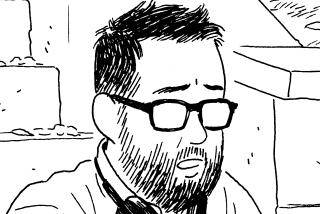Drawing on Cartoonistsâ World : * Convention: Aspiring artists, animators and funnies fans get a rare public peek at the minds behind the squiggles at Saddleback College forum.
MISSION VIEJO â How many people were at the head table at Saddleback Collegeâs âTop Cartoonists Forumâ? Who could tell?
Sure, there were Brant Parker and Mell Lazarus and Sergio Aragones and Kevin Fagan and Bil Keane and eight of their pals from the Southern California chapter of the National Cartoonists Society. All were giving The Word Saturday evening to a science lecture hall full of aspiring cartoonists, animators and funnies fans.
But if you hung around awhile, oddballs like Ralph and Norman Drabble showed up, and Momma and Francis, and Bung and The Spook and an entire smorgasbord of imaginary felt-pen wisps and flights of loopy fantasy. Little bits of them came bubbling up out of the menâs imaginations and, often, out of their felt-tip pens.
The evening was a kind of how-to for would-bes, but it also offered a rare public peek at the minds behind the squiggles, an Oz-like look at That Man Behind the Curtain, without the attendant ruination of the fantasy.
These guys who draw the funnies are fun.
Take Sergio Aragones, for instance. His most regular job--and the one that has brought him the most fame--is drawing for Mad magazine, where much of his work ends up cavorting in the page margins.
The panel wasnât yet seated Saturday when Aragones pounced on the overhead projector and, lightning-like, sketched out a pair of figures. One was a pleased-looking Neanderthal lugging an immense pencil, the other an insufferably haughty type in a bow tie. It turned out to be Cartoonist Economics Lesson One.
âThis is a comic book cartoonist,â said Aragones, pointing to the shaggy one. âAnd this,â he said, indicating the smug one, âis a comic strip cartoonist.â
That, as it turned out, just about covered one of the two main lessons of the evening: Cartooning can be a tough gig.
âThe highest-paid American is a cartoonist,â Aragones said. âAnd the lowest-paid American is a cartoonist.â
But, the panel members agreed, it can also provide a fine living--if youâre funny (second main lesson).
Jerry Scott and Rick Kirkman have learned that lesson. The pair, from Phoenix, began collaborating a year ago and created the strip âBaby Blues,â which now appears in more than 300 newspapers nationwide.
Scott, who also draws the modern incarnation of the classic strip âNancyâ for United Features Syndicate, said that he and Kirkman had been kicking around strip ideas âthat were just plain stupidâ about the time Kirkmanâs wife gave birth to the coupleâs second child.
Although Kirkman had begun to take on the sleepless pallor of the father of a newborn and looked fairly humorless at the time, said Scott, âI was entertained by these stories of what it was like to be a new dad.â He and Kirkman began to think other people might be, too.
New parents Wanda and Darrell and their infant daughter, Zoe, first appeared in the Scott/Kirkman portfolio under the name Oh, Baby.
It was rejected.
They decided to rename it âBaby Bluesâ and go to a single-panel format.
Rejected.
They then returned to the strip format but kept the new name.
Accepted.
Since then, the two and their little cartoon family have subtly poked at some of the constraints of the daily strip. For instance, said Scott, any strips addressing the subject of diapers (they showed the Saturday group one in which Wanda explains to Darrell how cloth diapers fundamentally differ from disposable) are almost sure to generate mail.
And, said Scott, the strip that âraised more alarm among executives than weâve ever seenâ involved an improvised bit of milk in Darrellâs morning coffee while Wanda was breast feeding.
Still, said Scott, he and Kirkman donât see themselves as crusaders for greater latitude on the comics page.
âThatâs not our purpose,â he said. âWe try to write better material week to week, and sometimes that involves pushing the envelope, but the main thing is honesty. Itâs fun sometimes to push the limits, but it has to be honest.â
And, said the cartoonists, the limits have been pushed.
âToonerville Folks,â a hit in the 1930s, likely wouldnât make it in the face of the sparser, sometimes edgier humor of todayâs funny pages.
âEven âBlondieâ has changed,â said Mell Lazarus, the creator of âMiss Peachâ and âMomma.â âYears ago, Dagwood missing the bus was funny in itself. Today, you want to know why he missed the bus.â
Bil Keane said that even in his 31-year-old âFamily Circus,â the boundaries have been stretched. He said Gary Larson, the creator of the often-bizarre âThe Far Sideâ has been a prime mover.
âHeâs made a different type of humor acceptable,â Keane said. âBefore, that type of humor was only seen in underground publications. It didnât have a general readership.â
As for his own comic, Keane said that he âused to not even be able to draw a toilet bowl. Now I can have the kids putting their heads in it.â
(That revelation brought a smile from Keaneâs son, Jeff, who assists his father in drawing âThe Family Circusâ and was the model for the character of Jeffy. Moderator Daryl Cagle called Jeff âthe only cartoon character on the panel.â)
One characteristic of the cartooning business appears to have remained intact over the years, however: A lot of people still want to get into it. To them, the panel offered bedrock advice:
* âDraw about a subject youâre familiar with,â said Bil Keane. âDonât try to fake it. It wonât work.â
Fagan concurred.
âI draw Norman (Drabble) as a dork in college,â he said. âI also was a dork in college at one time or another.â
Also, he said, his father would give him âthe glareâ when he was displeased, âand Normanâs dad gives him the glare whenever he goofs up, too.â
* Expect rejection. Steve McGarry, a Briton who draws âCelebrity Diaryâ for United Features Syndicate and the strip âBadlandâ for the London Sun, related the story of a cartoonist who got rejection slip after rejection slip (âSorry, not this time,â they read) and tacked each to his wall with his own added comment: âBastards!â
One day, said McGarry, the cartoonist got a rejection that read, âSorry, not this time. But thanks for asking.â On this one, said McGarry, he scrawled âPatronizing bastards!â
* Study. Practice. Stay with it. It might seem strange, said Aragones, to compare a cartoonist and a brain surgeon, but it emphasizes the need for artistic training.
âA (student) brain surgeon doesnât just say, âHey! I think Iâm just going to operate on this guy,â â he said. âIt takes a lot of love and patience and time to be good.â
After the skills are honed, he said, âit becomes easy. Itâs a part of you. It comes naturally.â
* Try to be flexible and versatile. Panel member Scott Shaw, for instance, has drawn comic books and ads, has produced and directed television shows and commercials, and has done animated drawing of âThe Flintstonesâ for television. However, he said, âdrawing funny stuff in comic books is a great way to collect eviction notices.â
Cagle, an advertising cartoonist, has drawn legions of monsters, kids, odd characters and fanciful folks for Mattel, McDonalds and General Foods. He also worked for eight years for Muppet creator Jim Henson in New York, where, he said, âI put pigs and frogs on everything imaginable. I must have drawn 10,000 Muppets over the years.â
* Innovate. Maury Turner, the creator of âWee Pals,â called his strip âthe first integrated comic strip in the nation, and Iâve been waiting for America to catch up to me ever since.â
* Donât be afraid to work alone. Most of the panelists said they did, at home. Most also said they liked the monkish atmosphere, although Shaw pointed out that âmonks have much more satisfying sex lives.â
* Be funny. It is, the cartoonists agreed, the single most important element in a cartoonistâs professional bag of tricks.
âI try to pack as much funny into each day to store up against the unfunny days,â said Scott.
Said Fagan, âI didnât make it on my artwork, thatâs for sure.â
He seemed intent on proving it. When one audience member asked each of the cartoonists to name their drawing instruments of choice, many came back with names of tools only insiders would recognize.
But not Fagan.
âI use a ballpoint pen from the Excalibur Hotel,â he said.
More to Read
The biggest entertainment stories
Get our big stories about Hollywood, film, television, music, arts, culture and more right in your inbox as soon as they publish.
You may occasionally receive promotional content from the Los Angeles Times.










